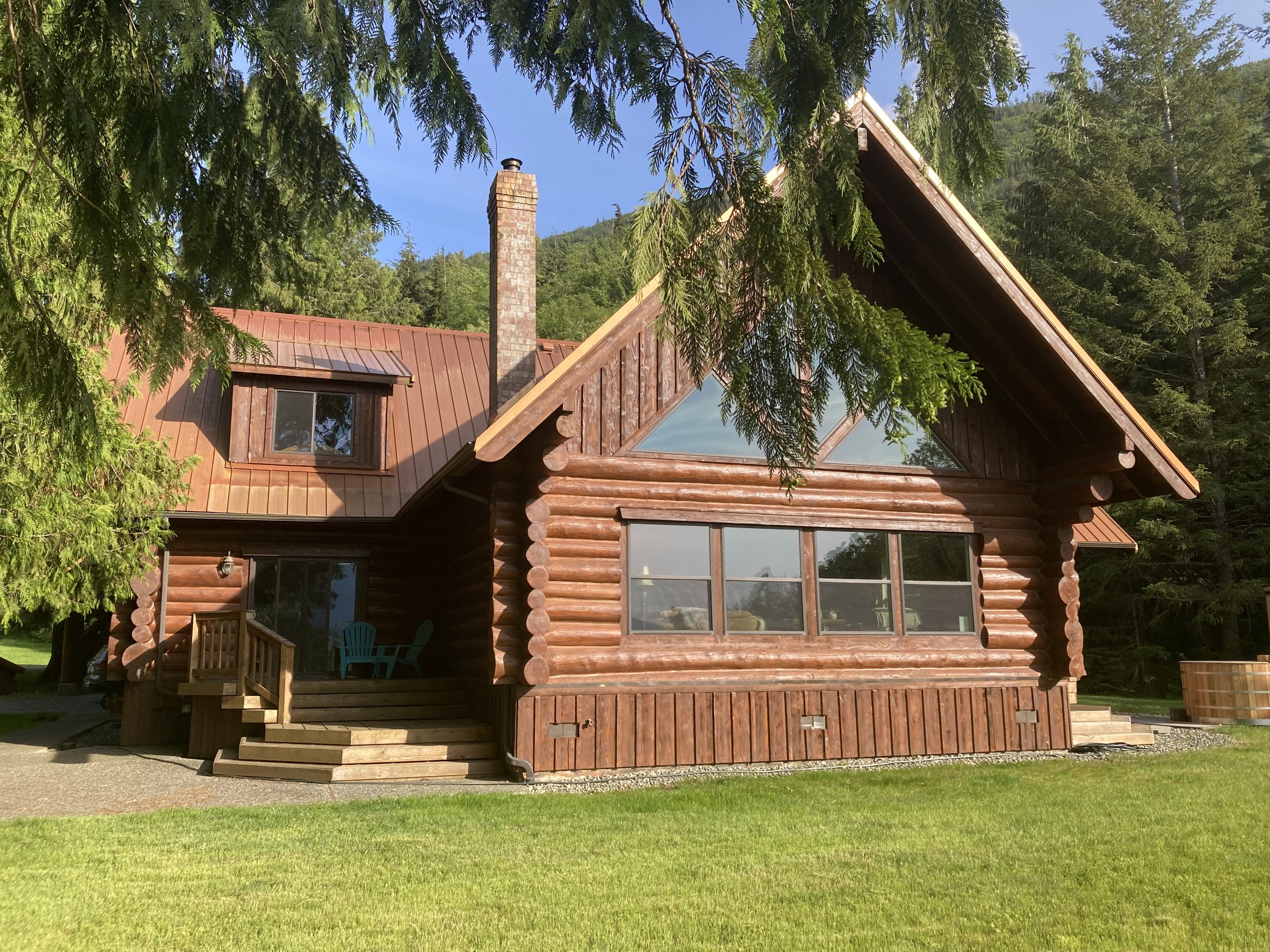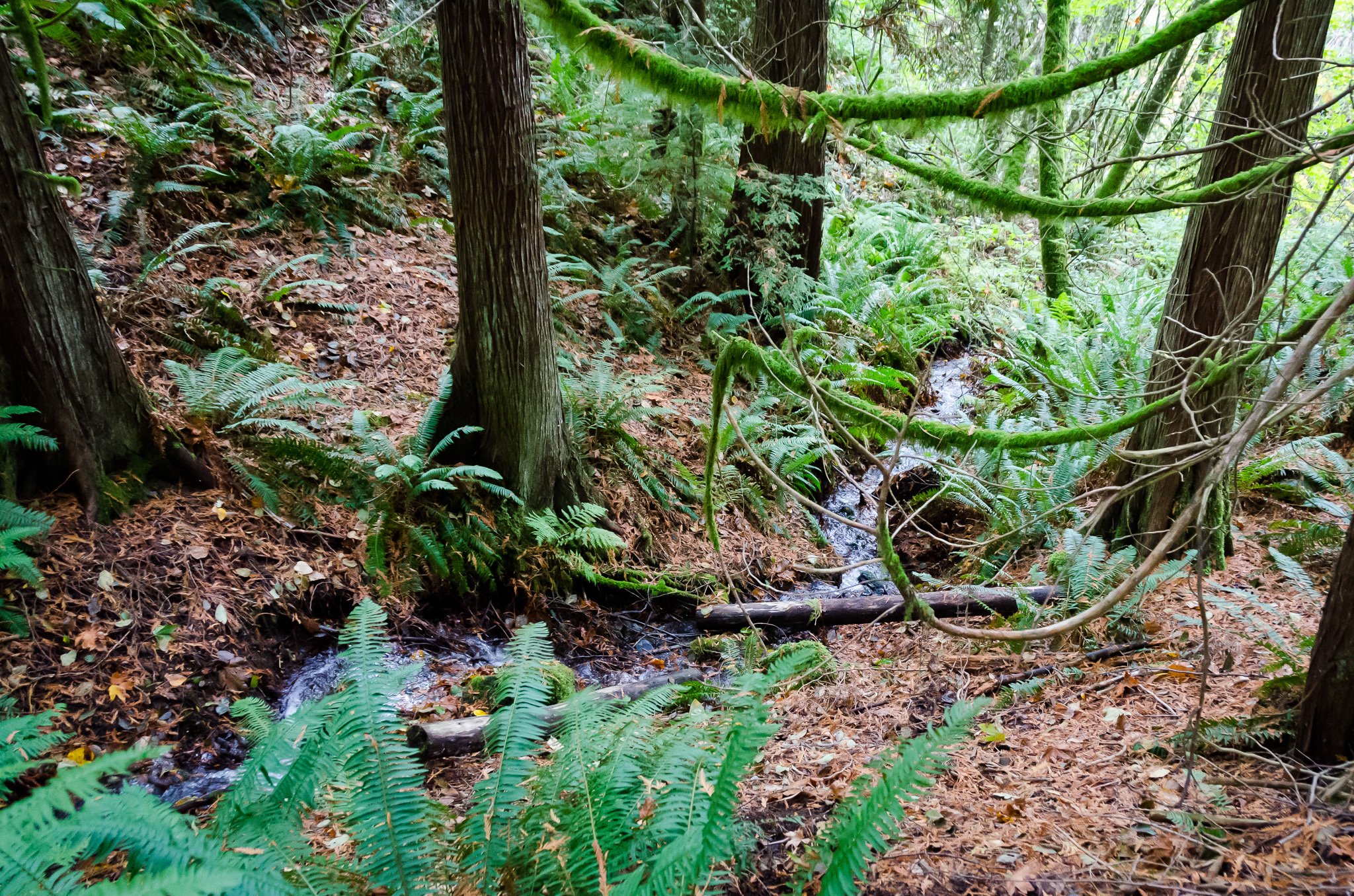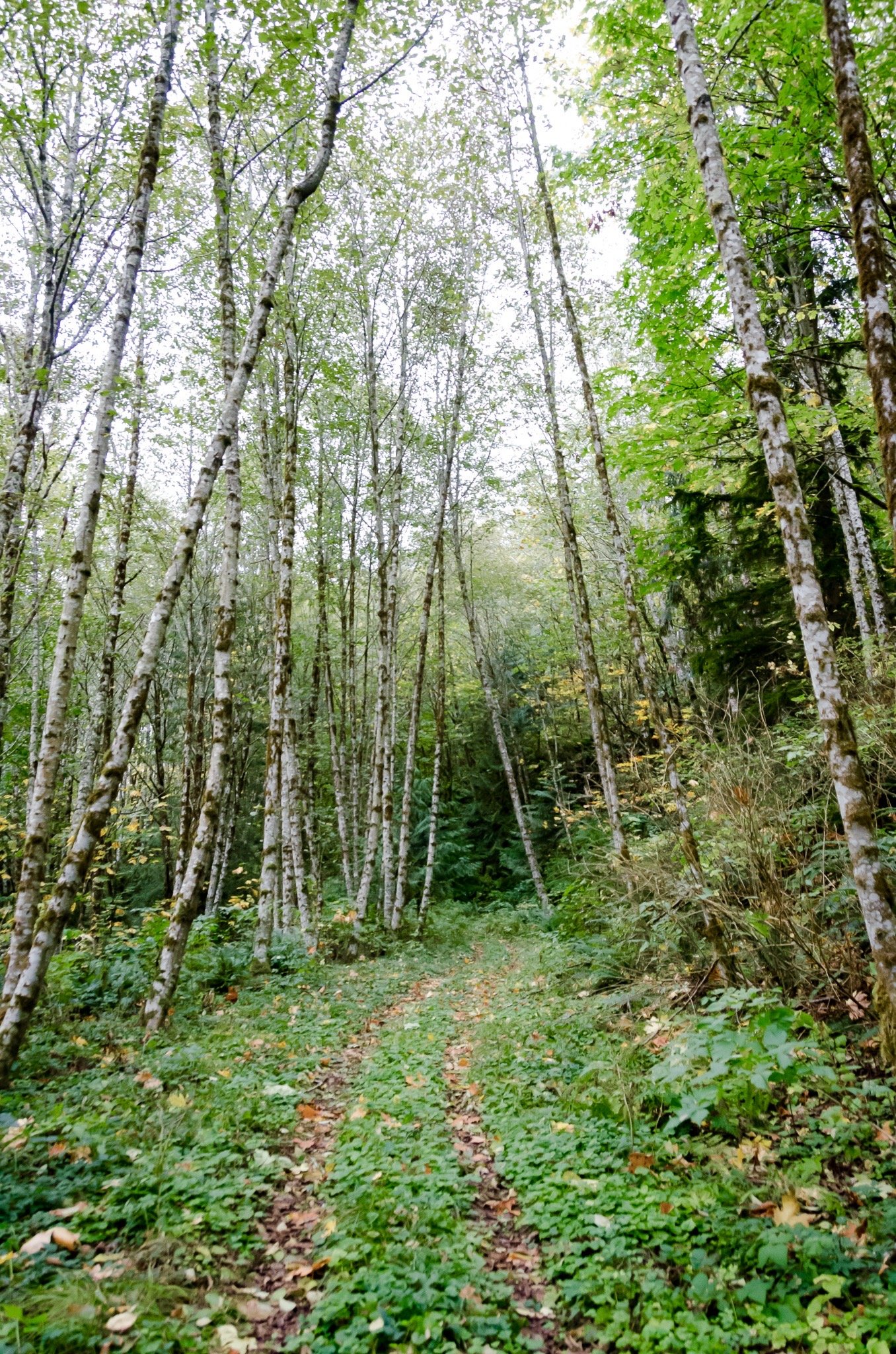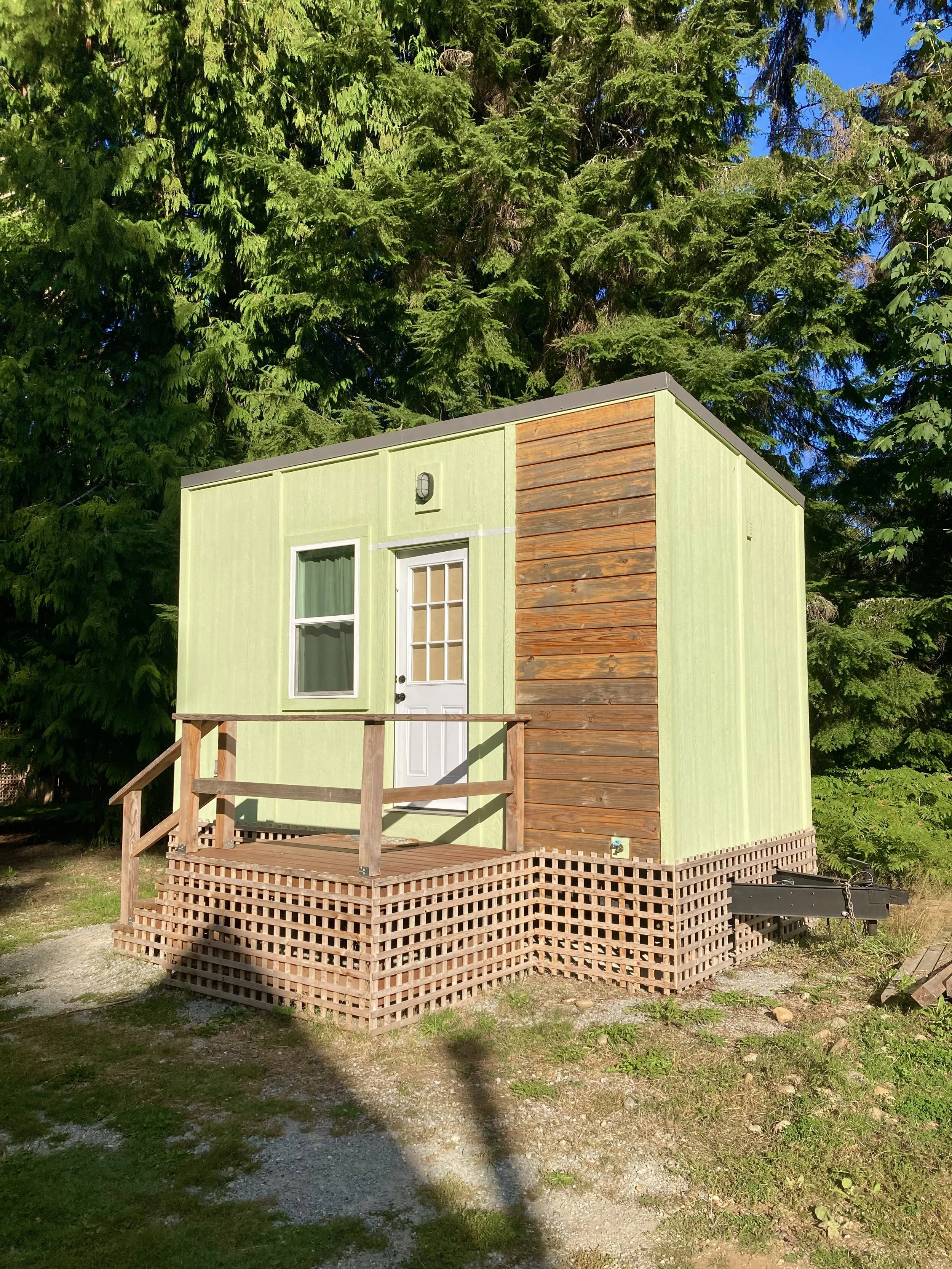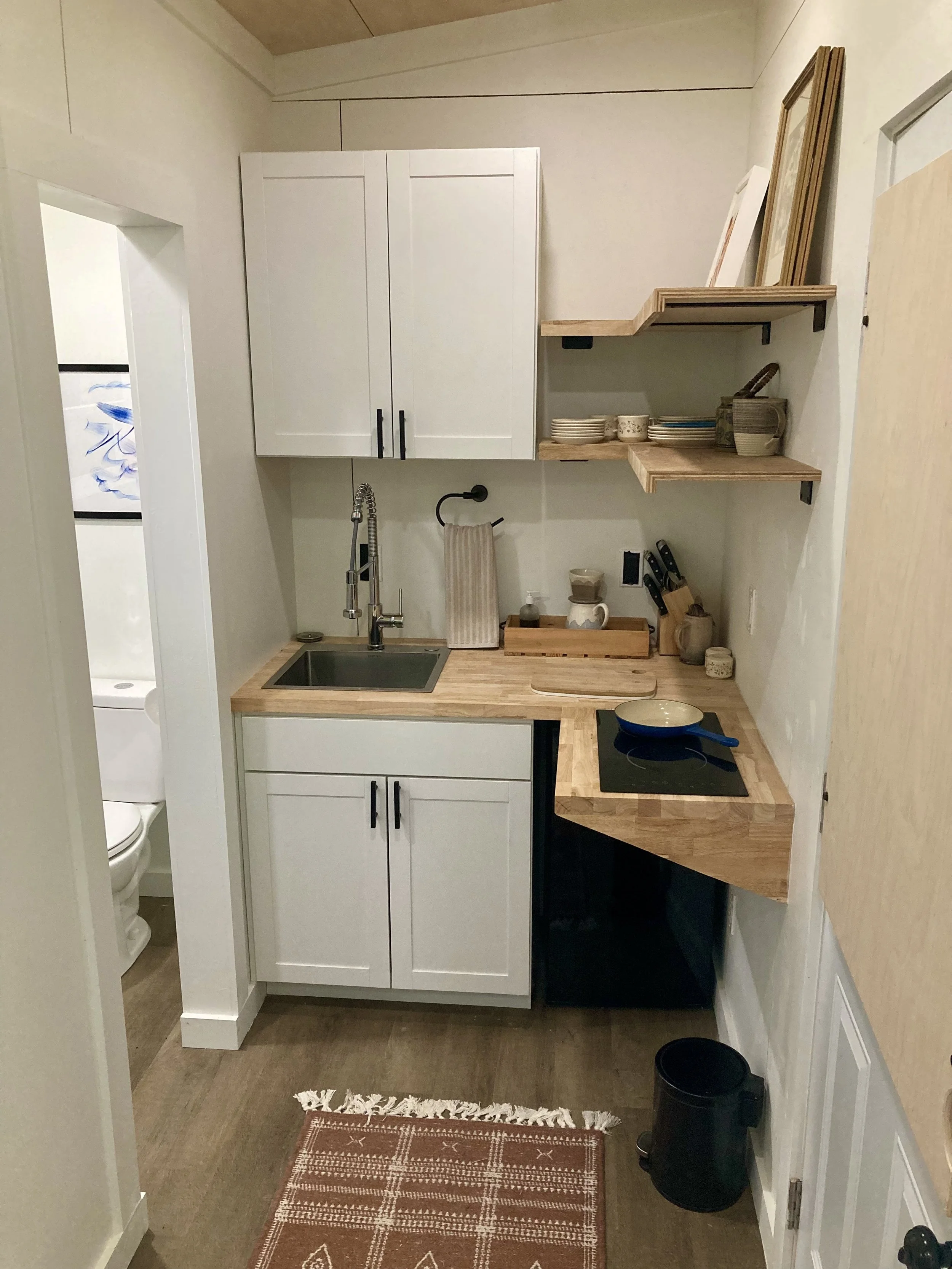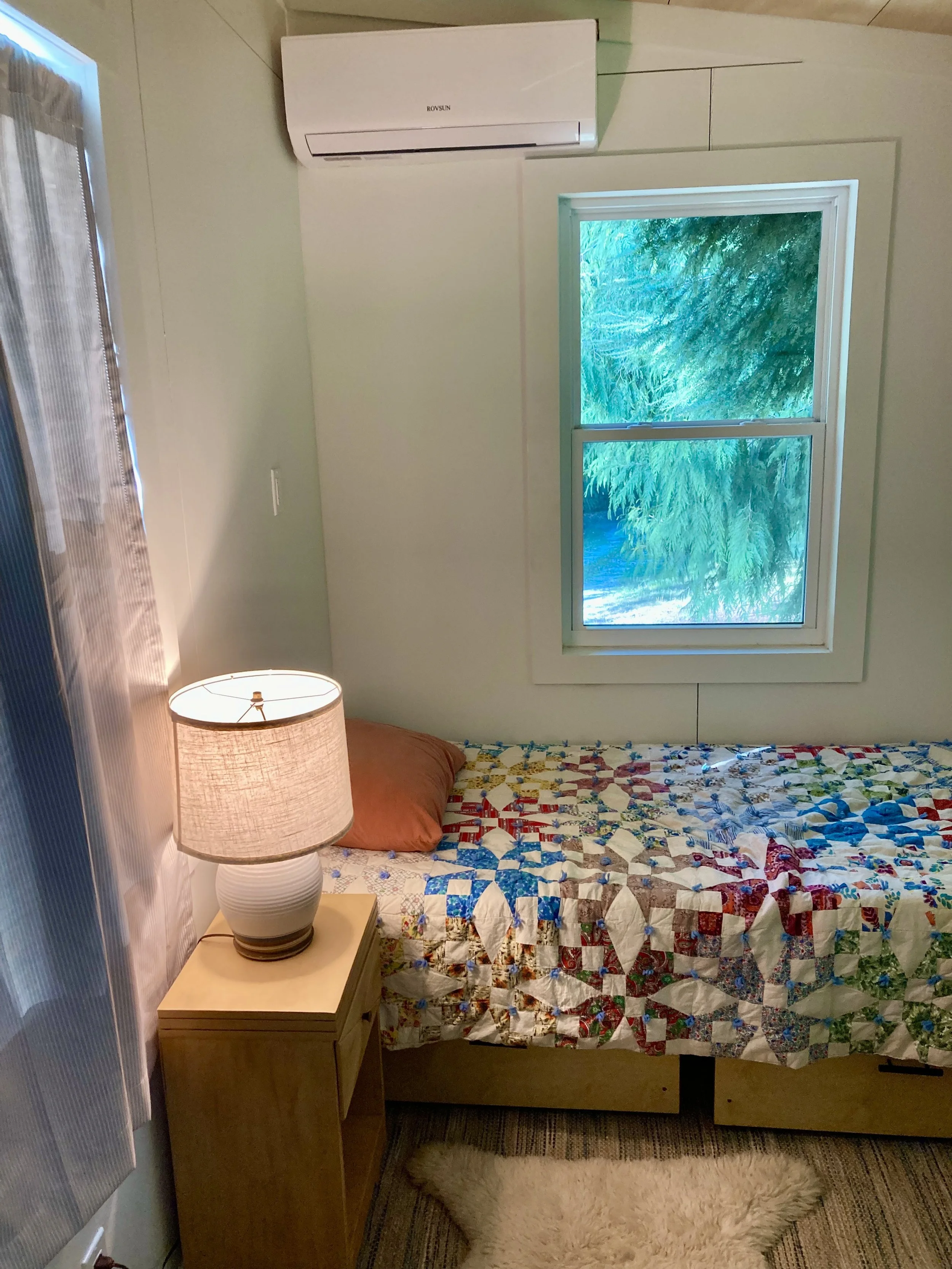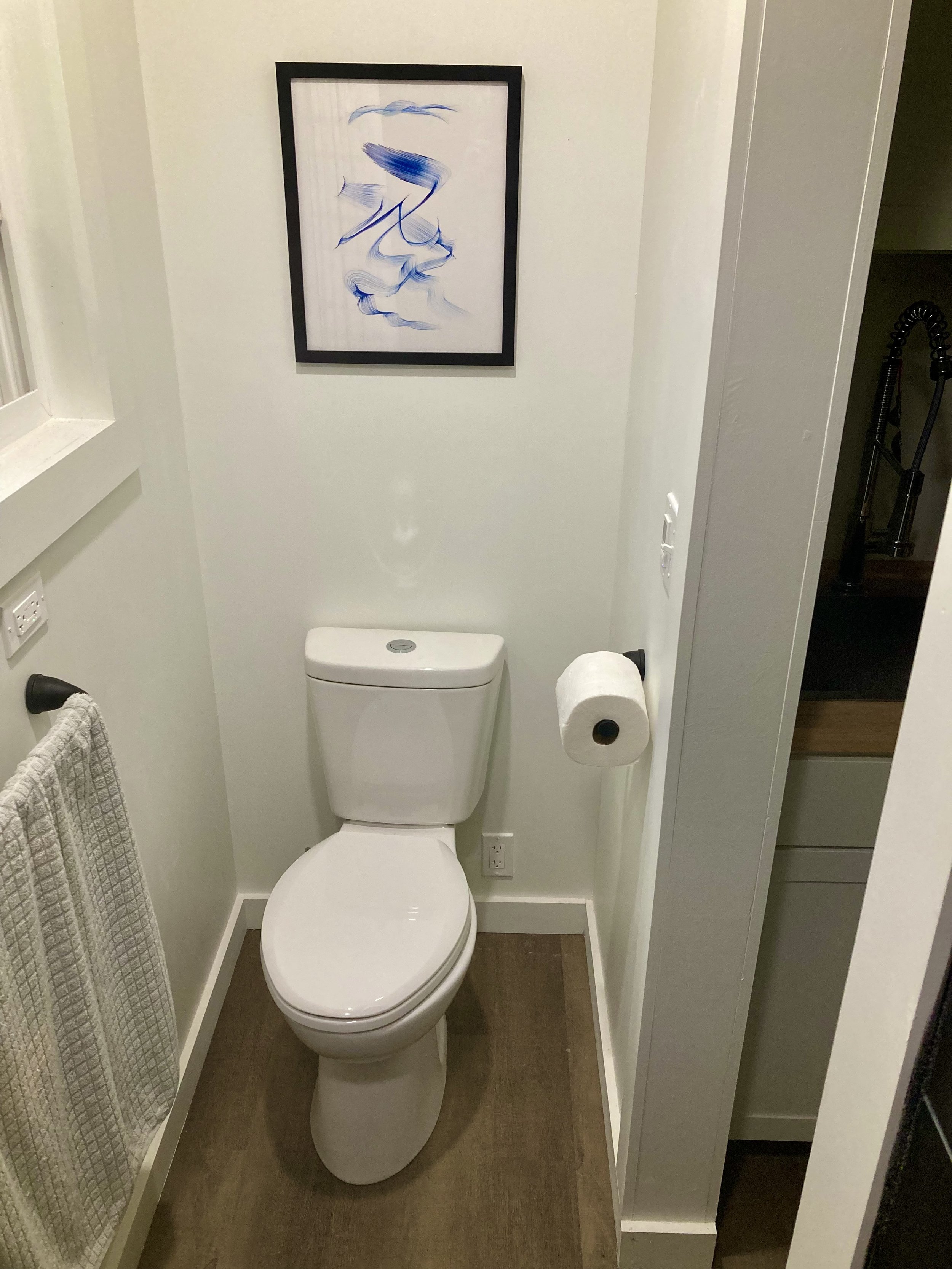About Us
We offer facilitated dark retreats in Sedro-Woolley, Washington. Our center is located on 88 acres in the foothills of the Cascade Mountains. We are an hour and a half drive from Seattle and fifty minute drive from Bellingham.
In addition to dark retreats, we host yoga, meditation, and breathwork retreats.
What is a dark retreat?
Dark retreats are an ancient form of spiritual practice in which one meditates in an entirely light free room for extended periods of time. Retreats of this nature usually last between 6 hours and 49 days.
Why do a dark retreat?
While retreat experiences vary significantly from participant to participant, many undergo deep rest, catharsis, and psychological healing while in retreat.
Our Retreat Space
We run dark retreats in a tiny home on wheels, which we black out using removable light blocking panels. It features a shower, flushing toilet, sink, and twin bed.
Frequently Asked Questions
-
Dark retreats are, to our knowledge, one of the safest forms of spiritual practice in existence. We know of only one person who has had a negative outcome from a retreat. This incident took place at a center that didn't offer as much in-retreat support as ours. We strongly feel that it could have been prevented with different pre-retreat suggestions and in-retreat support.
-
Our center is located approximately two hours north of Seattle-Tacoma International Airport and just under an hour south of Bellingham International Airport. If you arrive in your own car, you can park at our center for the duration of your retreat. Depending on our schedules, one of our team may be able to pick you up from an airport. Please let us know if this is an option you would like to look into. You can also use a ride sharing app or taxi.
-
We have found that beginning with a 1 - 4 day dark retreat tends to lead to good results.
After building experience, we have found that 12 day retreats can lead to significant benefits, but generally recommend exiting after that period of time.
We have also found that spending as little as 6 hours in a dark retreat can bring about significant rest and insight.
-
Yes. Our retreat room has a shower and we have found that showing in retreat can be very psychologically beneficial. We recommend taking at least one shower per day in retreat.
-
Yes, we provide two to three meals per day, depending on how much you would like to eat. The food we offer to our guests is usually vegan but we are happy to accommodate other dietary preferences.
-
Yes, we are happy to provide psychological support to you while you are in retreat. We can also help with any physical needs you have while in retreat, such as finding an important item that you have lost, cleaning up a spill, etc.
-
Yes, in fact, we require a preparatory zoom or phone call prior to the beginning of your retreat, and offer a free post-retreat integration call.
We also offer ongoing integration support.
-
On the most practical level, we recommend dividing your time between lying down, sitting up in a chair with back support, and sitting in upright chair without back support. Time spent sitting upright without back support directs one's awareness into the body, and can facilitate the process of catharsis.
This process often comes to completion in a more relaxed position, such as sitting in one of our arm chairs or lying down in bed.
We will walk you through meditative practices that we have found to be effective in retreat during your preparatory zoom call.
-
We recommend ending dark retreats in the morning. After emerging from a retreat, it is best to spend one full day doing very little. We have found that sitting and simply looking at your surroundings, walking, and journalling, are the best post retreat activities. A significant portion of the benefits and insights from dark retreats tend to come through on the day of emergence, and are far more likely to arrive and there is no interaction with digital technology for at least 24 hours after completing the retreat. We also recommend refraining from reading or listening to music during this period. Finally, we strongly recommend holding off on making any big decisions for at least three to five days following the completion of a retreat.
-
We have found that the following pre-retreat practices and lifestyle modifications generally lead to the best outcomes:
Limiting interaction with screens / digital technologies for 1 - 2 days prior to beginning the retreat.
Meditating for 30 minutes to 3 hours per day in the week leading up the retreat.
Refraining from any form of sexual activity in the week leading up to the retreat.
Note: This is not a hard requirement, but we have found that the most benefit seems to come from retreats in which it was followed.
We have also found that spending time in sensory deprivation tanks, also called float tanks, can be a great way to prepare for a dark retreat. Our friends at Float Seattle offer a discounted rate for guests considering doing a dark retreat with us. If you would like to take advantage of this discount, click here.
Dark Retreat Pricing
We charge $150 per night. This includes the cost of meals.
Note: For retreats lasting longer than 2 full days, we require that you book an extra day with us to integrate your experience.
For example, if you began a retreat on a Friday evening, spent Saturday, Sunday, and Monday in retreat, and ended the retreat on Tuesday morning, we would require that you spend all day Tuesday, as well as Tuesday night, at the center.
Our team
-

Sam Heller
Founder and lead facilitator
Sam is one of the most experienced dark retreat practitioners in the Western world, having completed 16 completely light-free retreats, lasting 6, 9, 11, 12, 16, 9, 12, 9, 12, 12, 12, 12, 14, 12, 12, and 11 days respectively. He also has experience and training in Yogic, Shamanic, and Tibetan Buddhist schools of spirituality. His primary influences and teachers include Craig Holliday, Dr. Stanislav Grof, Dr. James Pennebaker, Dr. Reggie Ray, Josh Watizkin, Dr. Gabor Mate, and Dr. Bessel Van Der Kolk. His retreat facilitation is strongly informed by his direct experiences while in retreat, and the work and teachings of the aforementioned individuals.
In his free time, he enjoys playing guitar, native flute and piano, painting, practicing yoga, slacklining, and playing pickleball and ping pong.
-

Craig Holliday
Advisor
Craig Holliday is a gifted Meditation and Spiritual Teacher trained in both the Yogic and Buddhist traditions and Licensed Professional Counselor (LPC). His teachers have included Adyashanti, A. H. Almaas, Gangaji, Caroline Myss, Matt Kahn, Lama Tsultrim, and Eckhart Tolle with Christ, Sri Aurobindo and the Buddha as his major influences. Craig began teaching after a series of profound awakenings with his teacher Adyashanti.
Craig offers Zoom sessions, retreats and workshops and meets with individuals from around the world who have a sincere desire to awaken out of our painful egoic existence and into this Beauty that we always already are. He offers mindfulness-based therapy, nondual therapy, meditation, yoga, kundalini support therapy, chakra instruction, and help for opening and healing the heart through surrendering oneself to the movement of Divine Intelligence.
For more info and teachings please see: https://www.craigholliday.com
-

Michael Lenarz and Nicole Tilson
Retreat Support
Michael Lenarz DC has 35 years of experience in business management and clinical practice. He has opened eight successful chiropractic businesses in multiple states, all of which are still operating successfully under current owners. He also operated a consulting business for over 10 years, servicing clinics throughout North America. Michael is also a published author with his book "The Chiropractic Way" published in 2001 by Bantam Books. He served for five years on the board of Trustees for Sharman College of Chiropractic, and has been awarded Chiropractor of the Year two times.
Nicole Tilson LMT, CCST, has five years experience as a licensed massage therapist in Washington State, and is a certified Craniosacral Therapist. She holds a Bachelor of Arts in Human Services from Western Washington University. Nicole is passionate about environmental regeneration and teaching individuals to reduce their dependence on commercial agriculture.
Michael and Nicole live on the retreat center property and provide additional support for dark retreat guests when Sam is away.
Testimonals
My dark retreat was profound to say the least. Thanks to Sam, I felt well cared for and this meant a lot to me. Since this can be not only an awakening journey but one of healing as well, I noticed old trauma patterns arising and just knowing Sam was there, if needed, helped those patterns soften. Altered states of being are something I regularly partake in whether it be through breath work, meditation or plant medicines but, being in the dark for most of 5 days…simply wow! This may seem scary to some but a friend of mine pointed out, if you can’t be with yourself, who can you be with? I love this insight. Remembering who we truly are at our core and experiencing self at this deep level is something I want to do at least once a year from now on. This was my first time with the extended dark and I would highly recommend both the retreat and Sam as a facilitator!
Tracy G.
Spending time in the darkness retreat was one of the most uniquely challenging experiences I’ve had. In the darkness, I was forced to face things about myself that I had been too busy and too afraid to confront. I realized how much of my identity is built on what I possess: achievements, status, external validation. Without all of that in the darkness, I had to ask myself—who am I, really? I also thought about my family. About how much they’ve given me, and especially how I’d taken them for granted. A sense of guilt and sorrow unsettled me, and I pray that I could one day make amends. Perhaps most deeply, I saw how much of my life has been spent running from my own insecurities—trying to prove that I’m good enough and capable enough. But in the darkness, I had to sit with the question: who am I beyond all that hiding? This retreat gave me the safe container to not just ask these questions—but to feel them. Thank you for offering something so rare and special.
M.L.
Sam inspired me with his stories about darkness retreats during a conversation at a winter Solstice gathering. Our conversation left me wanting to try one for myself. Sam was incredibly supportive. He talked me through all the preparation I needed for a 3 day retreat. I felt totally supported throughout and had an incredible experience. I left the retreat with no fear of darkness and with a deeper sense of peace and appreciation of my own mind.
Clive P.
I found myself being able to think more clearly and deeper into my life- the basics of where it’s going, what I want to do, who I want to be. I (also) had the most vivid dream I have ever had. I can’t remember the last time I had a dream so this stood out to me. I left feeling lighter, more clear minded, a bit like I had just had the best night sleep of my life.
Corinne F.
I did a darkness retreat with Sam for 24 hrs. Although I didn't see visuals or hallucinations, I rested a lot. I am someone who is always active and having the space to simply sit in pure darkness and quiet was incredibly calming for my nervous system. Sam made the experience very comfortable with healthy food and clean amenities. Would highly recommend working with Sam to see if this could unblock you in your journey.
Gautam A.
Contact us
If you have any questions or would like to book a dark retreat with us, please use the contact form below. We are happy to answer any questions you have via email, phone, or zoom.
Recommended Content
Below, you’ll find some of the content that we would recommend reading / watching prior to doing a dark retreat.
Except from “Healing Our Deepest Wounds,” by Dr. Stanislav Grof
“Holotropic states (such as those experienced in dark retreats) tend to engage something like an “inner radar,” automatically bringing the contents from the unconscious that have the strongest emotional charge, are currently most psychodynamically relevant, and are currently available for processing into consciousness.
This is a great advantage in comparison with verbal psychotherapy, where the client presents a broad array of information of various kinds and the therapist has to decide what is important, what is irrelevant, where the client is blocking, etc. Since there is no general agreement about basic theoretical issues among different schools, such assessments will always reflect the personal bias of the therapist, as well as the specific views of his or her school.
The holotropic states save the therapist such difficult decisions and eliminate much of the subjectivity and professional idiosyncrasy of the verbal approaches. This “inner radar” often surprises the therapist by detecting emotionally strongly charged memories of physical traumas and brings them to the surface for processing and conscious integration.
This automatic selection of relevant topics also spontaneously leads the process to the perinatal and transpersonal levels of the psyche, transbiographical domains not recognized and acknowledged in academic psychiatry and psychology. The phenomena originating in these deep recesses of the psyche were well-known to ancient and pre-industrial cultures of all ages and greatly honored by them. In the Western world they have been erroneously attributed to pathology of unknown origin and considered to be meaningless and erratic products of cerebral dysfunction.”
Excerpt from an interview with one of my primary teachers, Dr. Reggie Ray, in which he discusses his experience in a dark retreat
So the second step on the spiritual journey, at least according to the Tantric tradition, is that we have to dismantle the patterns of pettiness that are activated when we’re in our ordinary life. We have to dismantle them. Really, what happens in the darkness is, once the mind . . . once the mind really starts opening up, you start meeting some very interesting people. These interesting people are people from your past, but they’re people who are affecting you and actually taking you over right now as you live your life. These people are what I call, or what I might call undeveloped or incomplete parts of ourselves. They’re what Jung called complexes. They are little bundles of response, of conditioned response, that have developed in relationship to all kinds of situations throughout our whole life going back to probably when we were in the womb.
For example, in my case, I go into dark retreat, and the initial few days are very interesting, wonderful, and there’s a part of me that would like to say, “Okay, fine. I’m out of here!” but I stick with it because of this next step. What starts to happen is I will begin to encounter emotional responses that are very limited and very petty, and they arise in relationship to specific situations. I’ll give you an example. (We’ll see how far we want to go with this. You know, I’m not going to necessarily go through an archaeology of my personal psyche, but I want to give some examples.) As children, all of us have this experience of being very little and having these big people in our environment. The problem with the big people is, in our estimation, they were supposed to take care of us, and they had the power to resolve things that we couldn’t resolve—pain, hunger, fear, whatever—and they often didn’t do it. That experience is in us, and amazingly enough, as we discover through darkness practice, that experience of people who are bigger than us, and who could help us, but won’t do it, and the resultant response of resentment and anger and even rage, is activated all the time in our lives. It comes up all the time in relation to anybody we perceive as big. The problem with that response coming up is that we shut down. We shut down, and we actually live in the emotional state of that two year old. That’s how constricted our world is.
In my case, I’ve identified about sixty-five different what I call inferior personalities—inferior not in the sense of being bad, but just limited—and different situations in my life activate them. That’s what we call samsara: that we live from one limited state to the other, going from one to the other, depending on which external situation is going on out there. Do we feel betrayed? Do we feel undermined? Do we feel undernourished? Do we feel abused? Whatever it may be, we never get out. That’s what the prison is: It’s the kaleidoscope of these inferior parts of ourselves.
What happens in darkness practice is something will come up, and the interesting thing about darkness is, when they come up, they really come up. They take over the field of consciousness, and I become the two year old. The interesting thing is, usually in life when that starts happening, we go call a friend, or we’ll turn on the TV, or we’ll eat some chocolate, or we’ll have a drink, or we’ll get in the car and go shopping, but in the darkness, there are no breaks. In other words, when it comes up and takes over the field of consciousness, there’s nothing you can do about it. You’re stuck. Amazingly enough, that’s how you resolve that person: by becoming that person and living through the experience that person had from the beginning to the end, and sometimes it takes a long time—six hours, twelve hours, three days later it comes back—but that’s how you resolve karma, by completing the experience that got started, but because of our infantile and weak ego structure, we couldn’t do it at that time, and now here we are and that’s what we’re doing.
Excerpts from When the Body Says No, by Dr. Gabor Mate
“Several decades ago, David Kissen, a British chest surgeon, reported that patients with lung cancer were frequently characterized by a tendency to “bottle up” emotions. In a number of studies, Kissen supported his clinical impressions that people with lung cancer “have poor and restricted outlets for the expression of emotion, as compared with non-malignancy lung patients and normal controls.” The risk of lung cancer, Kissen found, was five times higher in men who lacked the ability to express emotion effectively.”
“Kissen’s insights were confirmed in spectacular fashion by a prospective study German, Dutch and Serbian researchers conducted over a ten-year period in Cvrenka, in the former Yugoslavia.”
“Nearly 10 per cent of the town’s inhabitants were selected, about one thousand men and four hundred women. Each was interviewed in 1965–66, with a 109-item questionnaire that delineated such risk factors as adverse life events, a sense of long-lasting hopelessness and a hyper-rational, non-emotional coping style. Physical parameters like cholesterol levels, weight, blood pressure and smoking history were also recorded. People with already diagnosed disease were excluded from the research project. By 1976, ten years later, over six hundred of the study participants had died of cancer, heart disease, stroke or other causes. The single greatest risk factor for death—and especially for cancer death—was what the researchers called rationality and anti-emotionality, or R/A. The eleven questions identifying R/A measured a single trait: the repression of anger.
“Indeed cancer incidence was some 40 times higher in those who answered positively to 10 or 11 of the questions for R/A than in the remaining subjects, who answered positively to about 3 questions on average.”
Maté M.D., Gabor. When the Body Says No (pp. 85-86). Turner Publishing Company. Kindle Edition.
Notes:
Additional research presented in “When the Body Says No” suggests that excessive hotheadedness is also detrimental to health. Ideally, from the standpoint of this research, one should try to find a balance between allowing themself to feel their emotions, without becoming excessively overwhelmed by them / attached to them.
Quotes worth considering:
“The unconscious insists, repeats, and practically breaks down the door, to be heard. The only way to hear it, to invite it into the room, is to stop imposing something over it—mostly in the form of your own ideas—and listen instead for the unsayable, which is everywhere, in speech, in enactments, in dreams, and in the body.”
Annie Rogers, professor emerita of psychoanalysis and clinical psychology at Hampshire College
“The process of meditation involves gradually shedding our multitude of opinions-built-upon-opinions of how things are, and becoming more and more aware of the literal, non-conceptual substratum of all our thinking — the substratum which is reality itself.”
Dr. Reggie Ray
“As long as you keep secrets and suppress information, you are fundamentally at war with yourself… The critical issue is allowing yourself to know what you already know. That takes an enormous amount of courage.”
Dr. Bessel van der Kolk
“I think 99 times and find nothing. I stop thinking, swim in the ocean of silence, and the truth comes to me.”
Albert Einstein
“Through embracing the shadow we discover its opposite.”
Craig Holliday
